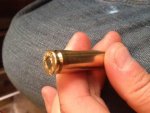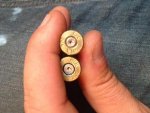I recently started reloading for the purpose of saving money. Last night I finally got to load my own ammo for my rem 700. I trimmed the once fired casings to 2.005. casings had already been tumbled, wiped clean, resized and punched the primer, put through the sonic cleaner, flash holes deburred, back through the sonic cleaner, dried, primed(f210), and loaded with IMR4064(38.2gr), topped off with hornady 168gr HPBT. COAL was set at 2.801.
I don't think I missed anything, but today I tried to shoot that ammo and found that some of the primers wouldn't ignite the powder. My first thought was headspace and that I trimmed too much and now the firing pin can't get leverage over the primer body. does that sound accurate? Anyone have any suggestions.
I don't think I missed anything, but today I tried to shoot that ammo and found that some of the primers wouldn't ignite the powder. My first thought was headspace and that I trimmed too much and now the firing pin can't get leverage over the primer body. does that sound accurate? Anyone have any suggestions.




